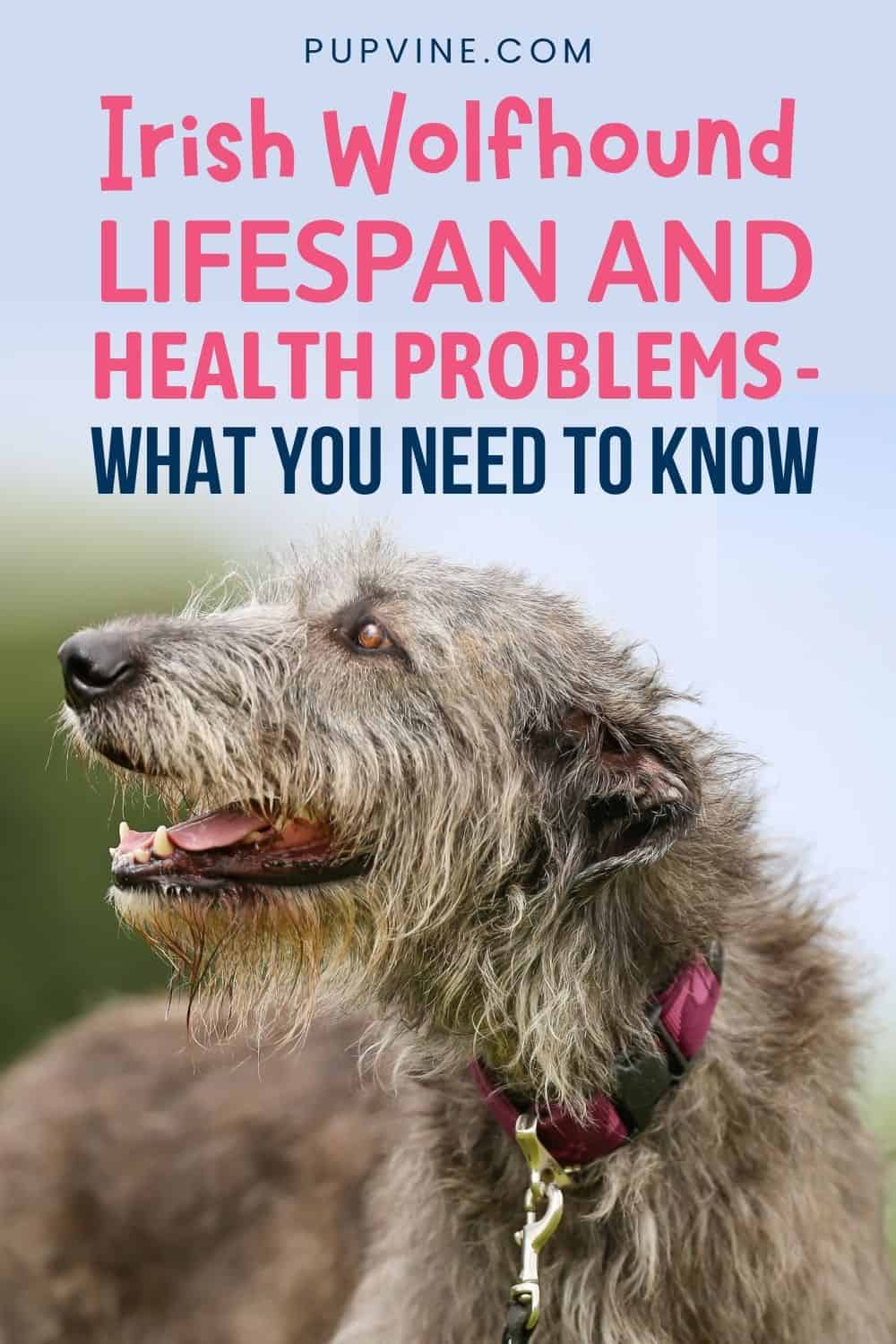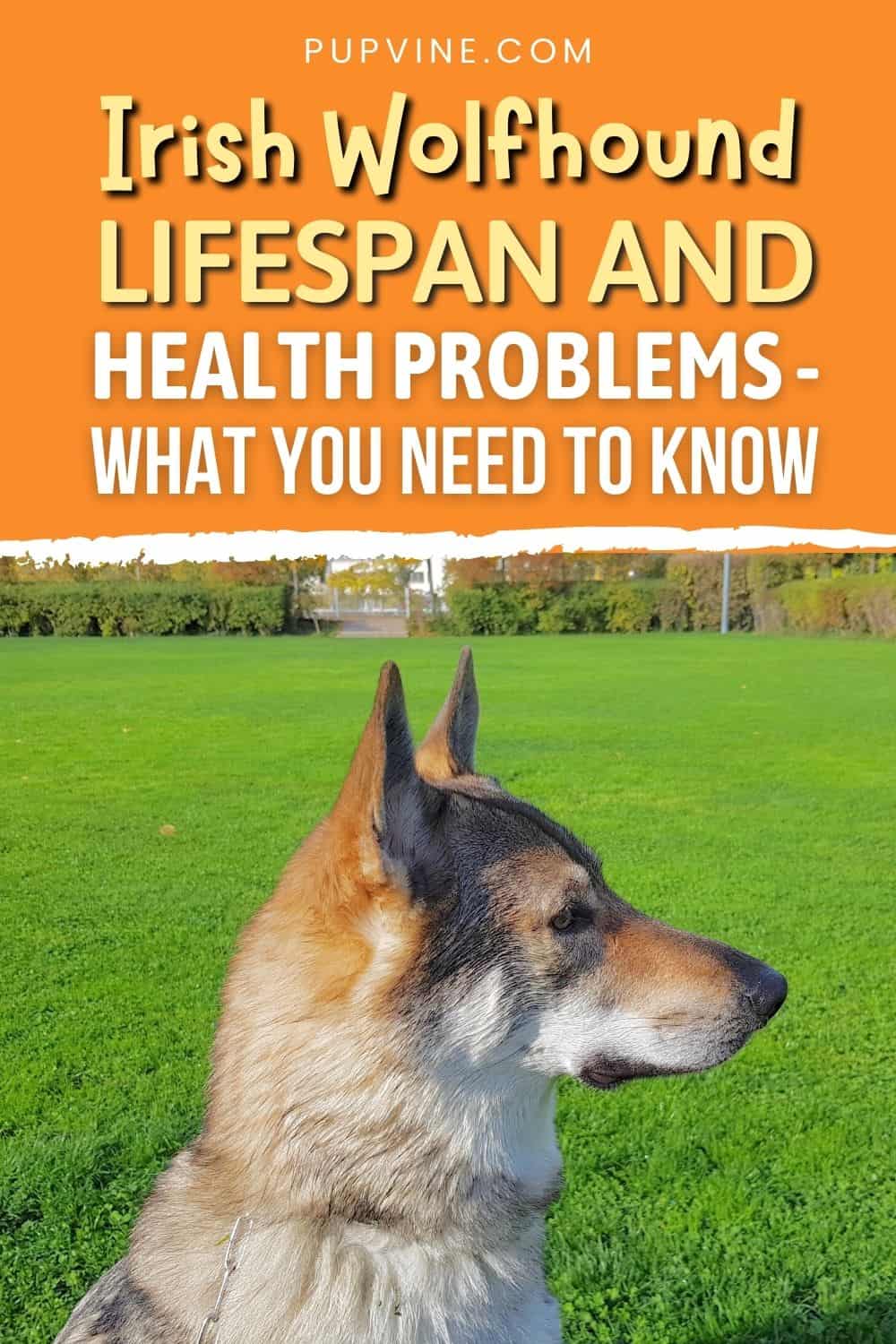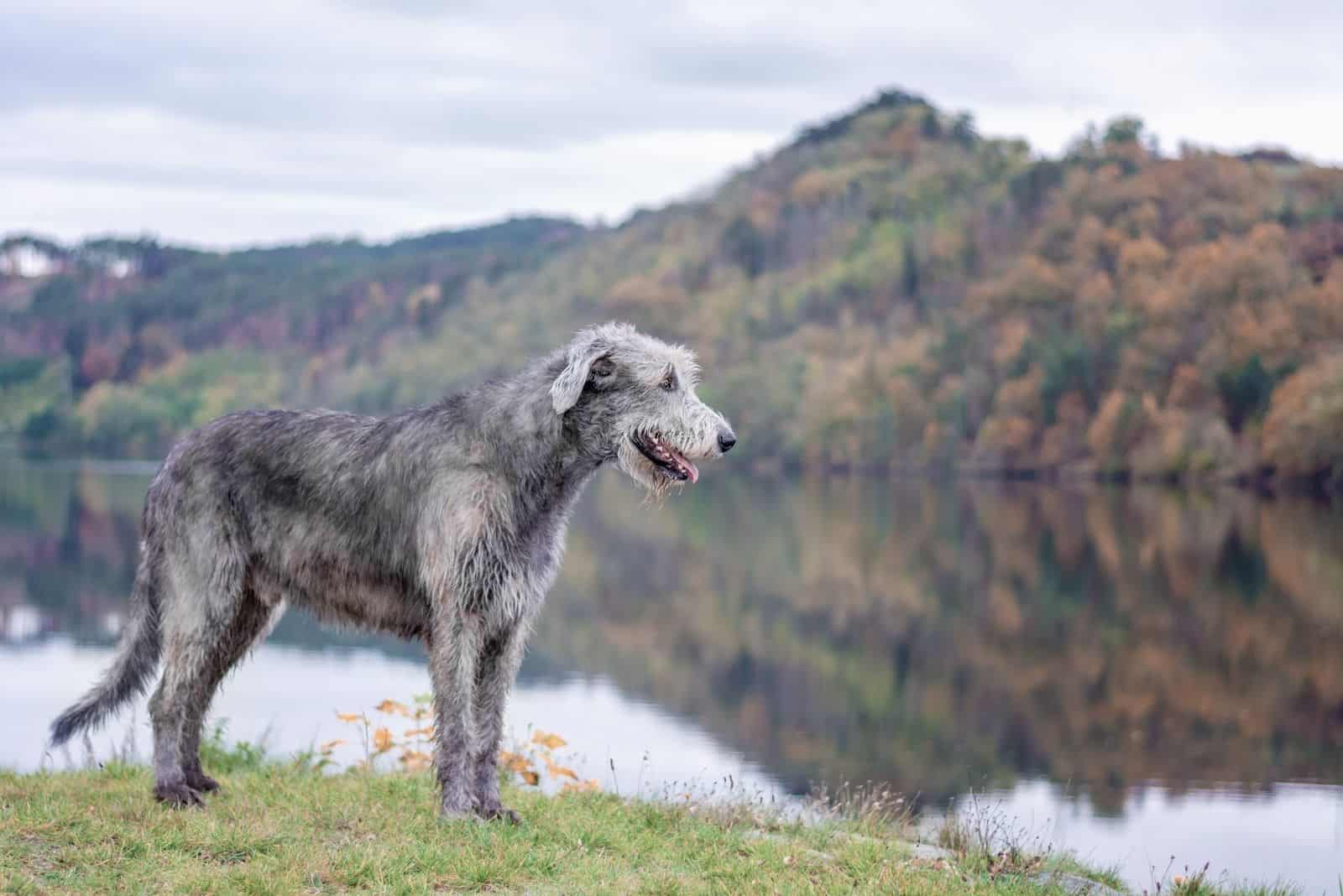It’s always painful to think about how long our beloved pets will stay with us. However, some things are inevitable, and it might help if we can know what to expect.
The Irish Wolfhound is a dog breed originally used by Roman consuls as a war dog that dragged men of chariots and horses.
They were also used as guard dogs, hunting dogs, and sighthounds, both in Rome and in Ireland. Their great size even allowed them to hunt the great Irish elk!
Today, however, they are rarely used in lure coursing. Instead, they make good family companions, and are loved by many dog owners worldwide.
As its name suggests, this dog breed originates from Ireland, but it was spread worldwide because people were fascinated with the height of the breed.
When we look at their average height of 32 inches, the Irish Wolfhound dog is the tallest breed in the world!
While there are some dog breeds that can be larger, such as the Mastiff or the Great Dane, there is no doubt that this is a big dog that will be the center of attention everywhere you go.
One of the people responsible for the creation of the Irish Wolfhound breed as we know it was Augustus Graham, who combined the Borzoi, the Scottish Deerhound, the Tibetan Mastiff, and the Harlequin Great Dane to get the desired appearance of his dogs.
The American Kennel Club (AKC) registered this brindle-coated breed in 1897, while the United Kennel Club (UKC) did so in 1925. A few years later, in 1927, the Irish Wolfhound Club of America was founded.
However, there is one big downside to this breed, and that is the short Irish Wolfhound lifespan. While this is sad, it’s important to understand why it is so.
If you want to know more about the average lifespan of this gentle giant, here’s what you need to know:
Lifespan of the Irish Wolfhound
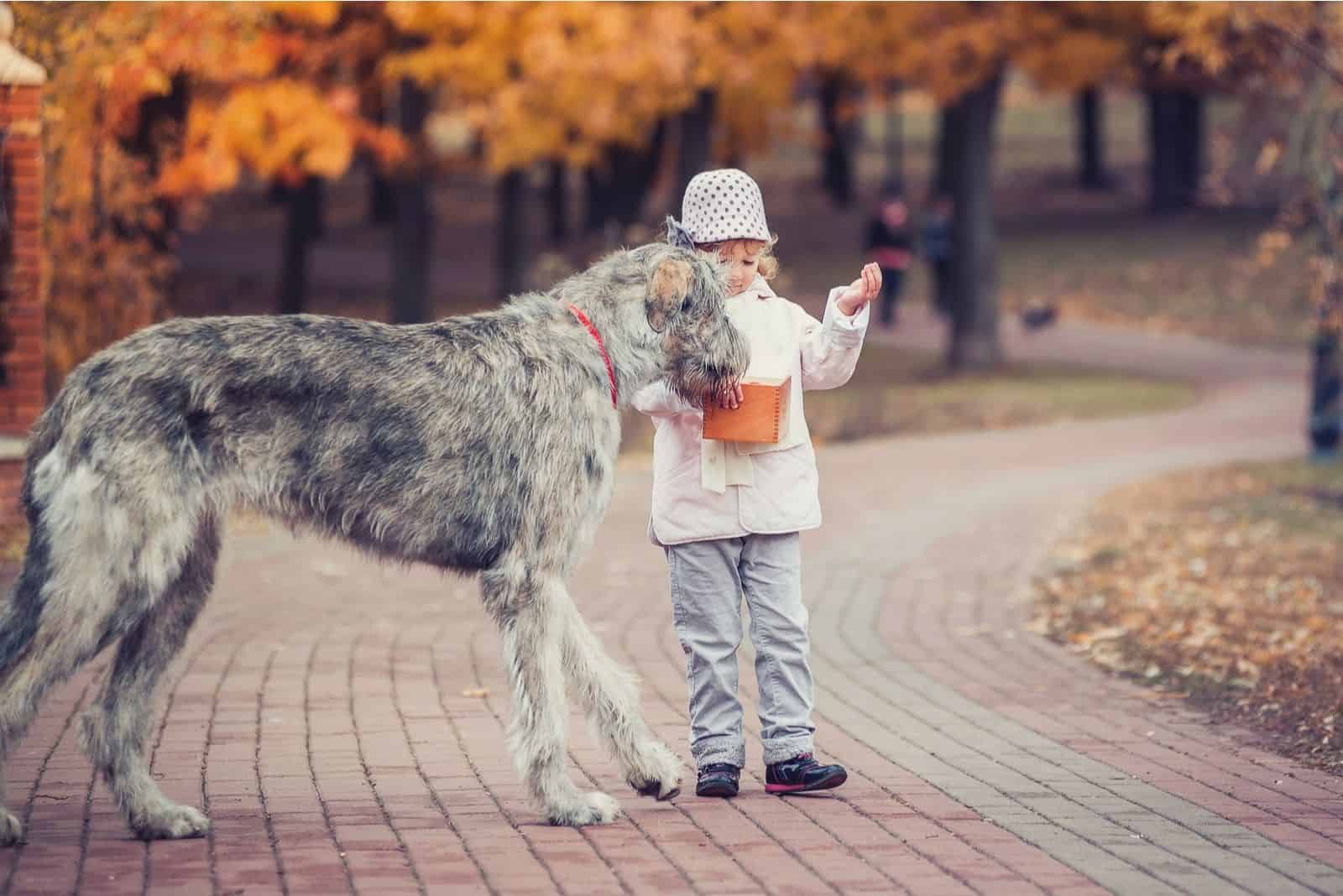
Unfortunately, the Irish Wolfhound lifespan is among the shortest ones out there. These pups only live between 6 and 10 years, with an average life expectancy of 7 years.
This lifespan is very short, even when compared with dog breeds of similar size. For example, Great Danes live around 9 years on average, while the English Mastiff lives approximately 8 years.
Why Do Irish Wolfhounds Live so Short?
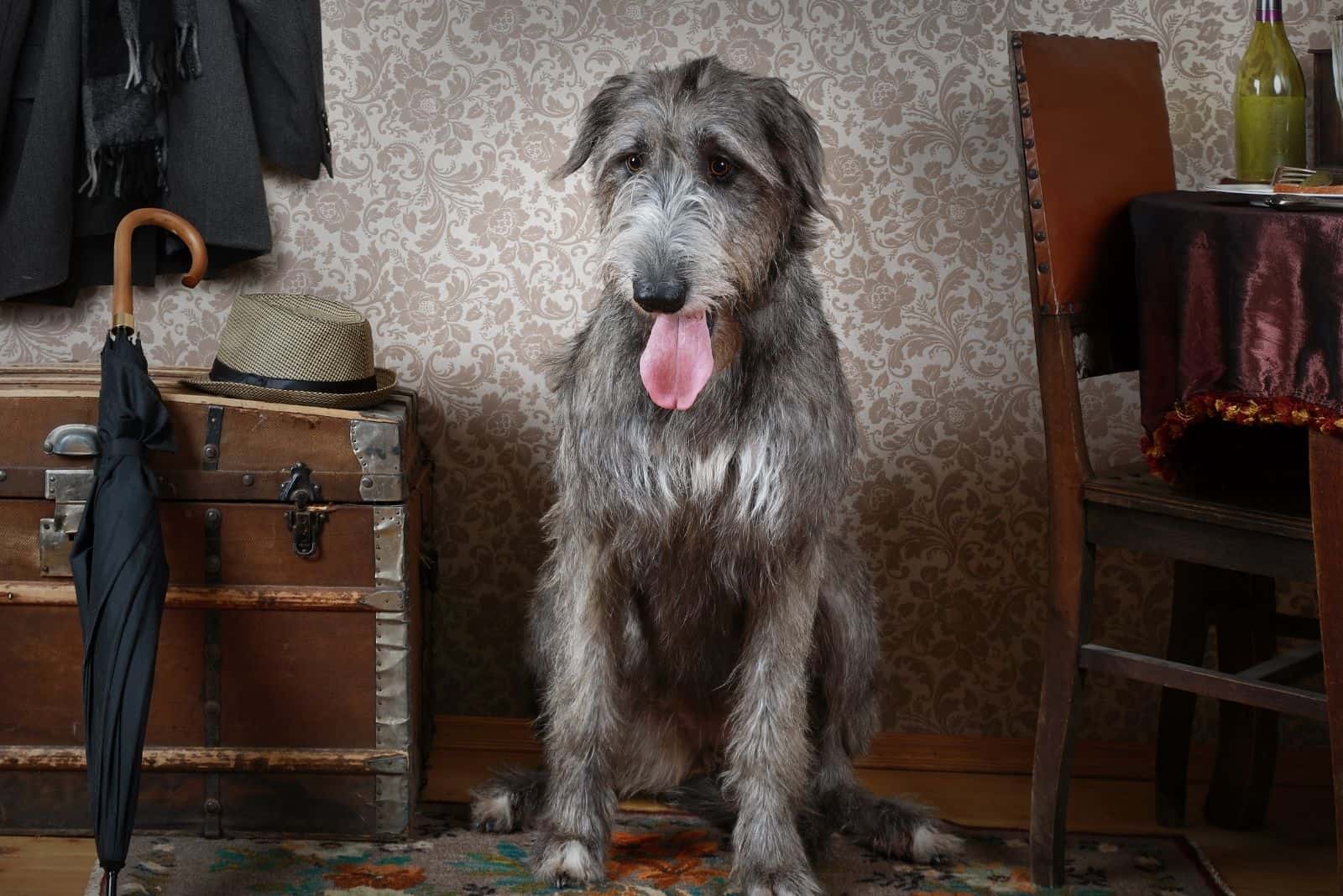
There are several reasons behind such a short lifespan of these giant dogs.
First off, this dog breed is prone to many health conditions that can shorten the life of your beloved wolf-dog. We’ll talk in-depth about this later on.
Another problem is their large size. Let’s elaborate.
Small dogs tend to live longer than large ones. Just think about pups such as Pomeranians, Chihuahuas, or Lhasa Apsos. These pups can live more than 15 years! On the other hand, giant breeds tend to live significantly shorter.
One of the reasons behind this is that the vital organs of smaller dogs don’t undergo as much pressure and stress as that of large dogs.
The Irish Wolfhound bodies have to carry all that weight, and this can make organs such as the heart work much harder, shortening their lifespan.
The second reason is that larger dogs grow faster. Think about it. When doggies are born, they are almost all the same size. There isn’t such a big difference between a newborn Irish Wolfhound puppy and a Chihuahua puppy.
However, the difference is significant when the pups are only two weeks old! This is a clear indication that large breeds grow much faster than smaller ones.
Unfortunately, fast growth also means faster cell reproduction, and this is usually not a good thing. When cells divide rapidly, there are greater chances of something going wrong. To put it plainly, this is how cancers happen.
The Irish Wolfhound Health
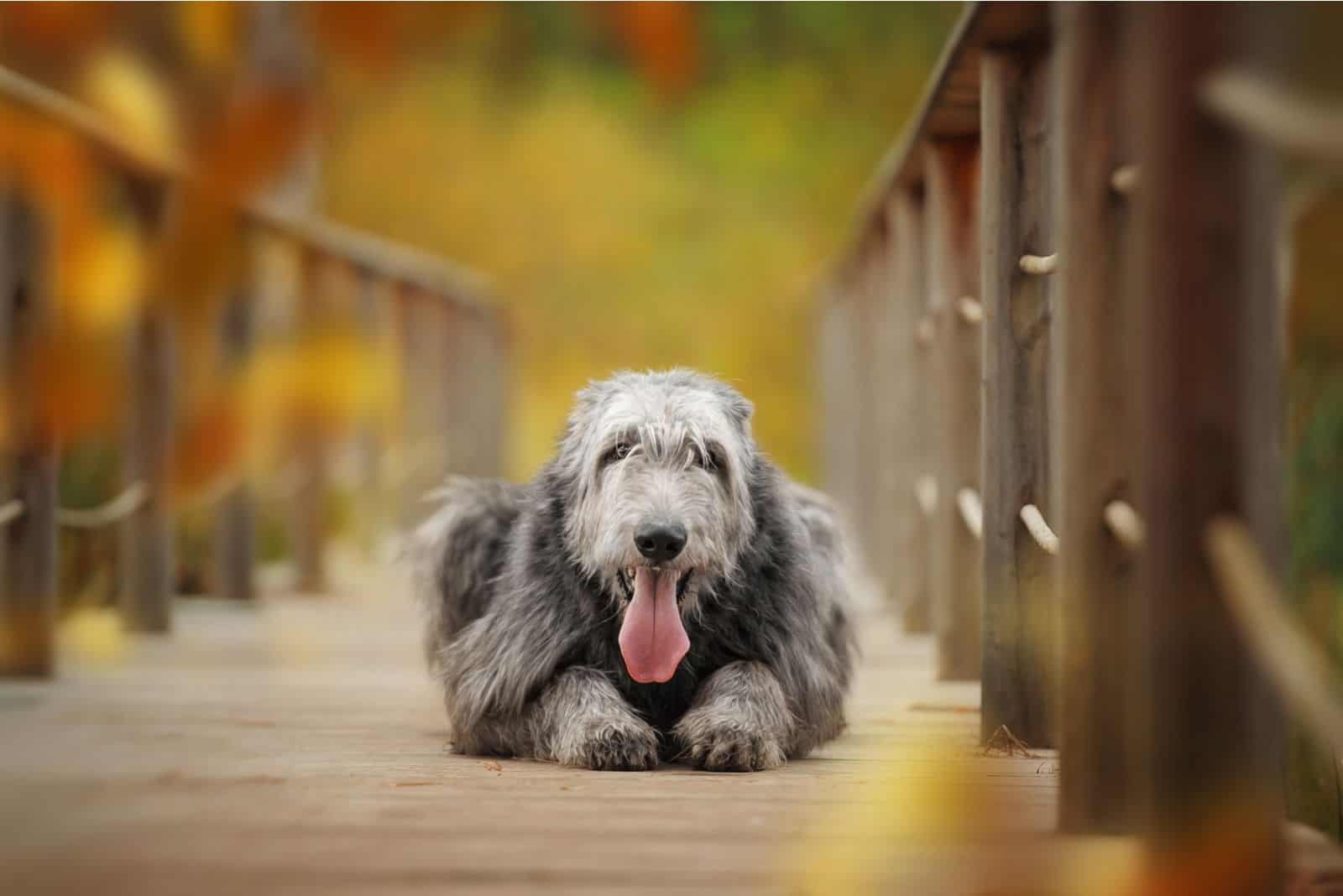
Sadly, like mentioned before, Irish Wolfhounds are prone to several health conditions that can shorten their lifespan. While not all of these pups will necessarily get any of these diseases, the chances of this happening are likely.
Many of these health problems can affect the Irish Wolfhound lifespan. Plenty of them lead to fatalities, and some aren’t treatable. To the dismay of many Irish Wolfhound owners, many such conditions cannot be detected during genetic testing.
Here are some of the most common health issues in Irish Wolfhounds:
Hip Dysplasia and Elbow Dysplasia
Many veterinarians would say that hip dysplasia is the ‘mother of all orthopedic diseases’. This is a condition that is prevalent in large dogs, but it’s common in smaller dog breeds as well. In fact, even cats can have it!
This is a genetic disease that causes degradation of the inner workings of the hip joint. It causes the ball portion of the femur to align poorly with the pelvis’ hip socket.
This means that your Irish Wolfhound won’t be able to have smooth movements, and walking can cause pain.
Elbow dysplasia is very similar, except that it affects one or both joints located on the elbow.
Both elbow and hip dysplasia can be very expensive to treat. While some mild cases can be kept under control with just pain medication, more severe cases have to be treated with surgery.
These conditions won’t directly affect the Irish Wolfhound lifespan. However, they can cause stress, which can lead to other, more dangerous diseases.
Fortunately, dysplasia is very preventable, and with just a few life changes, you can keep your pup healthy from it. More on that later.
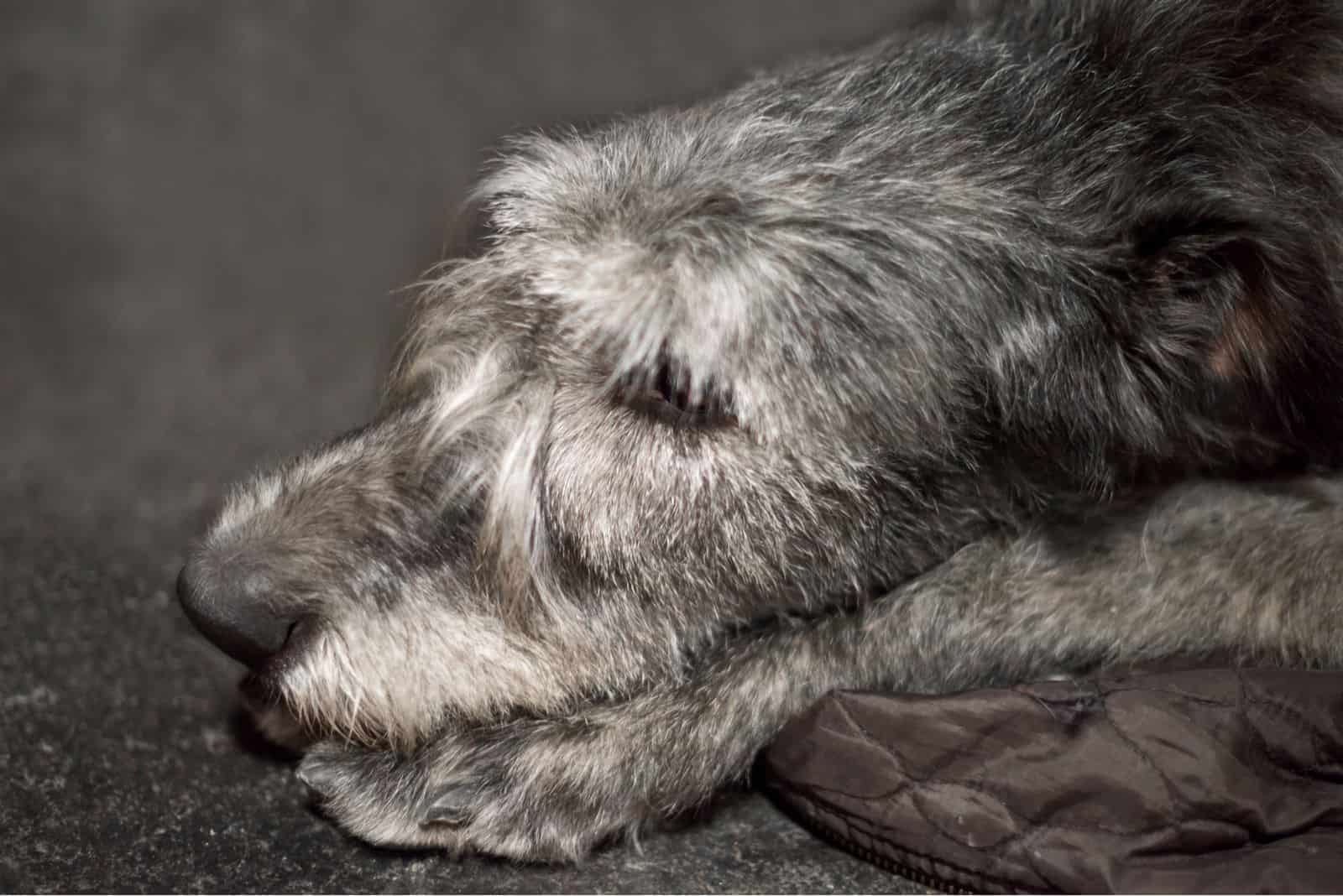
Panosteitis
This is a fairly common orthopedic condition. It’s usually found in young large breeds of dogs, especially in those growing at a rapid pace.
In dogs with panosteitis, the outer bone layer, the periosteum, becomes inflamed. This can be quite painful for the dog that is likely already dealing with the discomfort of the rapidly growing bone.
Dogs that are around a year old are the most common age group for this painful disease. Also, male Irish Wolfhounds tend to be more prone to the condition, with around 70% of all cases affecting male dogs.
While certainly ruining their quality of life, panosteitis isn’t life-threatening. It will usually resolve in a matter of weeks, although some cases can last longer.
Autoimmune Thyroiditis
Autoimmune thyroiditis is a type of thyroid disease that some dogs are genetically predisposed to.
Other than Irish Wolfhounds, other dog breeds such as the Golden Retriever, the Cocker Spaniel, the Dachshund, the Doberman Pinscher, and the Irish Setter are prone to it.
The thyroid gland is located in the neck, and it produces several very important thyroid hormones. These hormones are important for canine metabolism, and when they aren’t produced properly, they can cause many health problems.
One of the most notable problems is hypothyroidism, which occurs when there is a lack of thyroid hormones. This causes the metabolism to slow down, leading to obesity, among other things.
Hypothyroidism usually occurs after a condition that causes destruction to the thyroid gland, but it can also be a product of cancer or a congenital defect.
This is yet another health problem that can be treatable with medication. The sooner you diagnose it, the less likely it is to cause long-lasting damage to your Irish Wolfhound’s body.
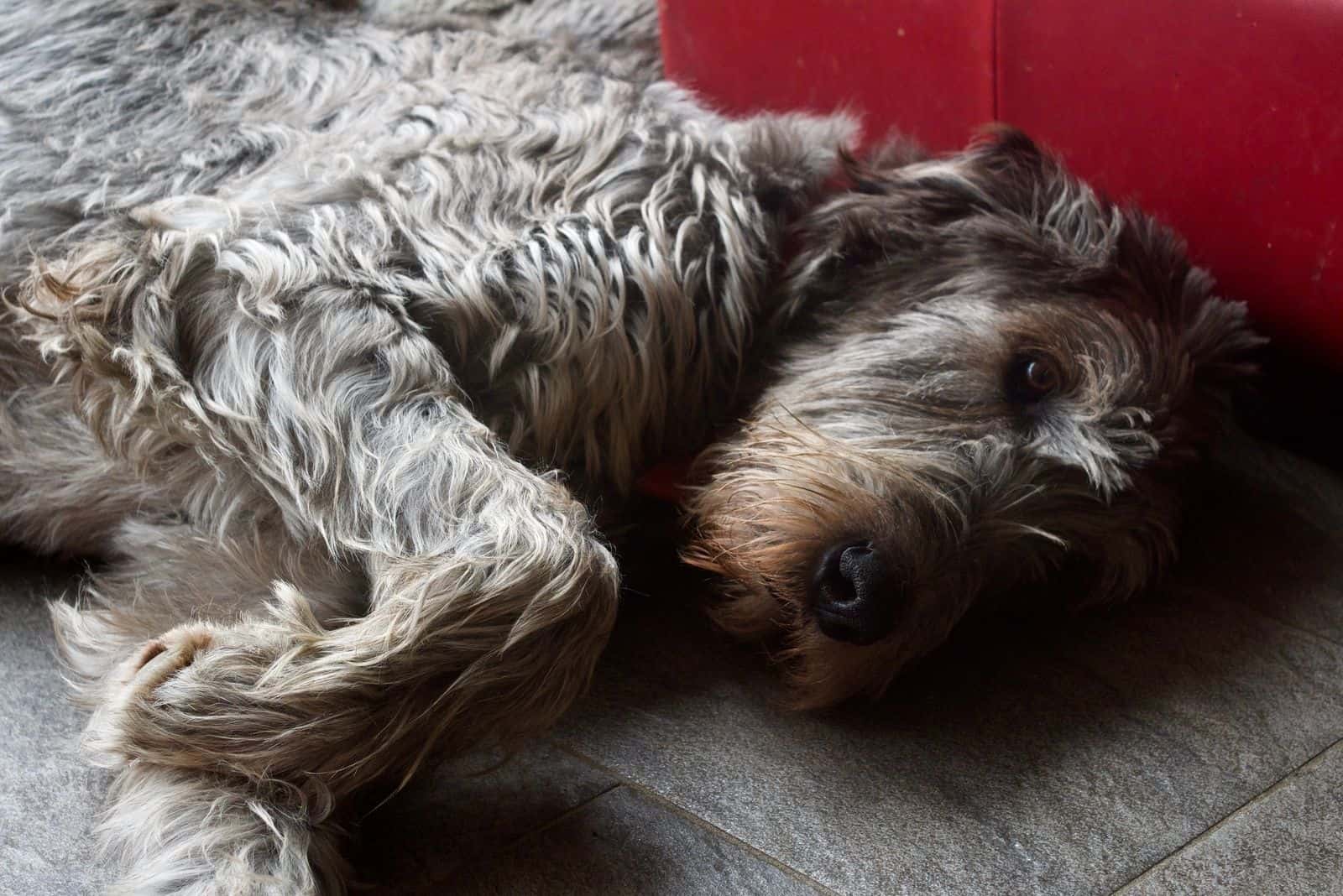
Progressive Retinal Atrophy (PRA)
Generalized progressive retinal atrophy is a genetic disease that can be found in dogs. It causes degeneration of the photoreceptors located in the back of the eye (retina).
There are two types of this condition. The first one, also known as retinal dysplasia, has an early onset, and it mostly affects puppies that are no older than three months. The other one occurs in adult dogs.
As PRA develops, it causes progressive sight loss. Over time, this can lead to blindness. In most cases, the dog will become entirely blind in a year or two.
While there is no effective treatment for PRA, you’ll be glad to know that this isn’t a painful condition and that it won’t affect the Irish Wolfhound lifespan. Blind dogs can live just as happily as they don’t understand their problem the same way we do.
Von Willebrand’s Disease (VWD)
Von Willebrand’s disease is the most common genetic blood disorder in dogs. It happens when there isn’t enough coagulant glycoprotein, which is called the Von Willebrand’s factor.
This disorder affects the blood’s ability to clot, leading to prolonged bleeding. It’s similar to hemophilia, but it’s caused by different genetics.
There are three types of this disorder depending on the concentration of the Von Willebrand’s factor and its structure. Fortunately, the Irish Wolfhound is mostly prone to type 1, which is usually the least severe one.
The symptoms of this disease may vary. Some dogs won’t even express any bleeding tendencies, but they’ll be the carriers. More severe cases can have spontaneous bleeding from the mouth or nose, and the urinary, intestinal, or reproductive tracts.
Uncontrollable bleeding may also occur after surgeries, and also from much less invasive procedures such as teething or declawing.
So far, there isn’t a medication that can help improve blood clotting, and the vets can only treat the symptoms. Severe bleeding can shorten the Irish Wolfhound lifespan, and it might even be fatal.
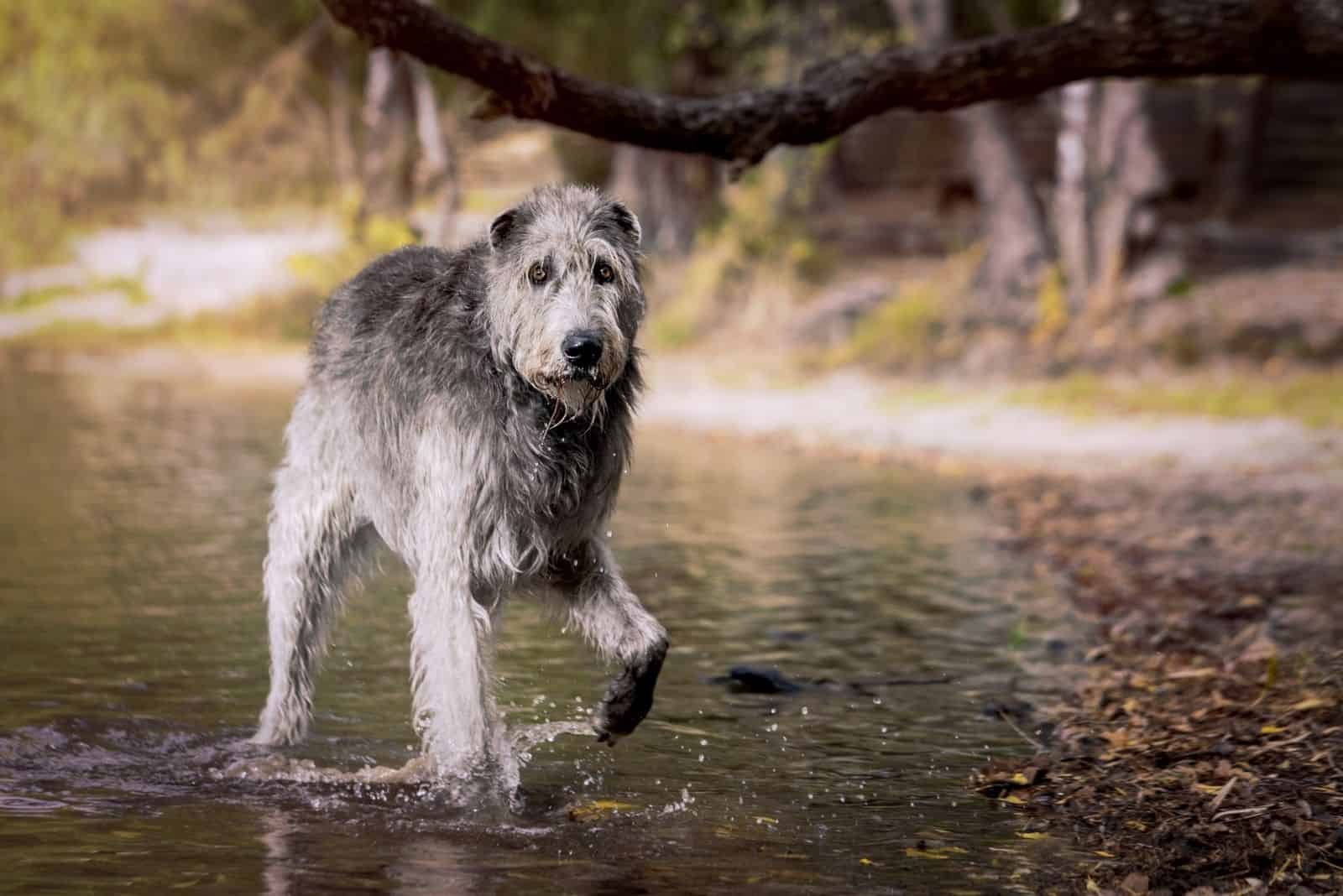
Liver Shunt
The liver shunt, also known as the portosystemic shunt or a hepatic shunt, is a health condition during which the blood vessels have malformed, so they bypass the liver.
In a healthy liver, the blood vessels go through the liver, which then cleans them from toxins and releases the healthy blood back into the body.
However, in dogs with liver shunts, the abnormal vessels go around the liver without stopping, so the blood never gets cleared of the toxins, and the liver doesn’t get the right amount of blood. This allows the toxins to move around the body.
With most dogs that are born with a liver shunt, the symptoms become noticeable early on. However, in milder cases, affected dogs won’t show signs for years.
In most cases, this health condition can be fixed with surgery. However, some complicated cases cannot be operated on, and the only solution is to give your dog medication that will help reduce the toxins inside its body and deal with other symptoms.
If left untreated, a liver shunt can be deadly. As such, it’s clear to see how it affects the average Irish Wolfhound lifespan.
Cardiomyopathy
Cardiomyopathy is an umbrella term used for all heart diseases that affect the heart muscle of the pet. There are three types of cardiomyopathies, and it isn’t known what causes either of them:
• Dilated cardiomyopathy
• Hypertrophic cardiomyopathy
• Restrictive cardiomyopathy
The symptoms of cardiomyopathy can vary. All types of this condition can lead to difficulty breathing, collapse, and blood clots. In severe cases, these can lead to paralysis or even death.
Fortunately, vets can usually notice cardiomyopathy before any of the visible symptoms occur. This is because the disease is usually followed by heart murmurs that can be heard on regular echocardiograms.
On occasions in which the dog is diagnosed on time, most cardiomyopathies can be managed with proper medication. This is why it’s important that you never miss the annual vet check-up.
The biggest issue with cardiomyopathy is that it can happen suddenly, and there is no way to predict it. A dog that was healthy one day can develop heart problems the next day without any warning.
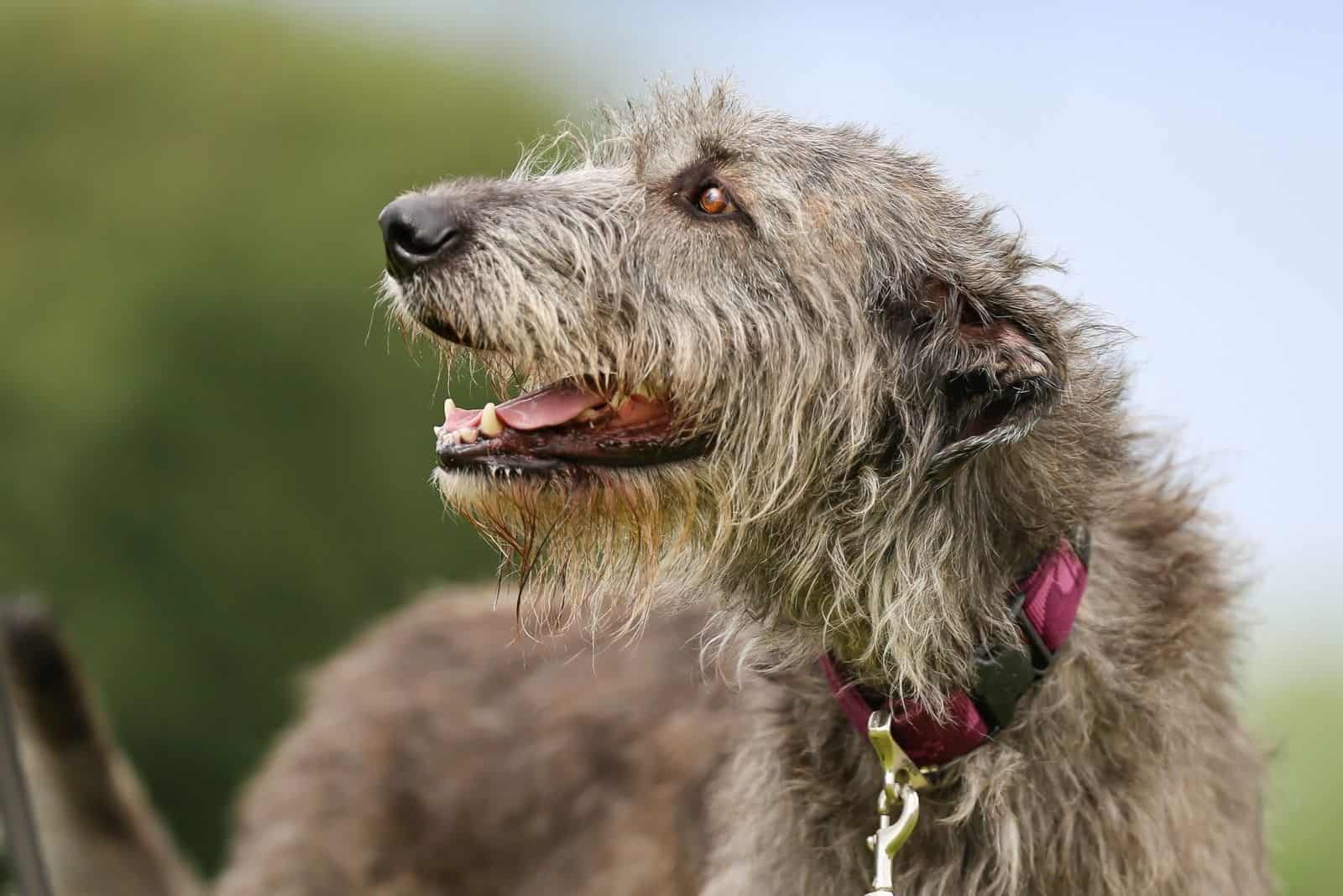
Gastric Torsion
Gastric torsion, also known as gastric dilatation volvulus or bloat, is one of the deadliest conditions in large dog breeds.
This health issue occurs when a dog experiences a sudden accumulation of gas inside its stomach, which then twists. Once this happens, every second counts.
Bloat is very deadly because the twisting also affects the blood vessels supplying the stomach. If the blood supply is cut off, it can lead to irreversible stomach death, the release of deadly toxins, shock, and death.
Unfortunately, sometimes there is no help for a dog suffering from bloat. This condition attacks quickly, and it can kill your dog in a matter of minutes. It is one of the main reasons behind such a short Irish Wolfhound lifespan.
Cancers
Cancers, just like bloat, are the main cause of death of the Irish Wolfhound. Sadly, these large dogs are prone to tumors – more specifically, to bone cancer, also known as osteosarcoma.
Osteosarcoma in Irish Wolfhounds usually occurs in one of their legs. It isn’t known why the breed is susceptible to it, and why it affects this area the most.
If discovered on time, osteosarcoma can be treated with surgery. Sadly, even this isn’t a guarantee that your dog will be cured, and osteosarcoma remains among the most deadly cancers in dogs.
How Do You Increase Your Irish Wolfhound Lifespan?

Photo from @mulligan_iwh
Sadly, you can never truly know whether or not your dog will suffer from a certain health condition or how long he’ll live. Still, there are some things you can do to help increase the chances of him living a long and healthy life.
Here are some things you can do:
Keep Him At a Healthy Weight
Dogs can easily become overweight or even obese. They’ll always try begging for food, and once you start giving in, they’ll do this all the time. However, this can ruin your Irish Wolfhound’s quality of life.
While not overly prone to obesity, thanks to their large size, these dogs, just like all others, love to eat. Dog owners, on the other hand, will give their pups a treat for just about anything!
Whether that is positive reinforcement during training, or to stay calm while you’re brushing out dead hairs from your Irish Wolfhound’s double coat, you’ve probably given your dog one treat too many, at least once!
Overweight dogs are at a higher risk for many health problems, including cardiomyopathy, cancer, and bone issues.
To prevent this, you should only give your dog healthy, high-quality dog food. You may also attempt to replace classic treats with healthier alternatives such as paprika.
This also includes giving your pooch enough exercise. Irish Wolfhounds have lots of energy that they’ll need to get rid of.
It’s essential that you provide them with at least two daily walks, joined by half an hour of heavy exercise such as playing a game of fetch or tug of war.
Keep Him Mentally Stimulated
Irish Wolfhounds are smart dogs, which means they can get bored easily. This can lead to destructive behavior and stress, which can increase the chances of injuries or deadly diseases.
Give your Irish Wolfhound interactive toys that they can play with for hours. This will keep their gray matter active. Some toys work by forcing your dog to think about how to reach the treat hidden inside of it. These types of toys work great on an always-hungry dog.
Just keep in mind that this type of toy also has calories, so make sure you count that in. Treats should never make more than 10% of the dog’s daily calorie intake!
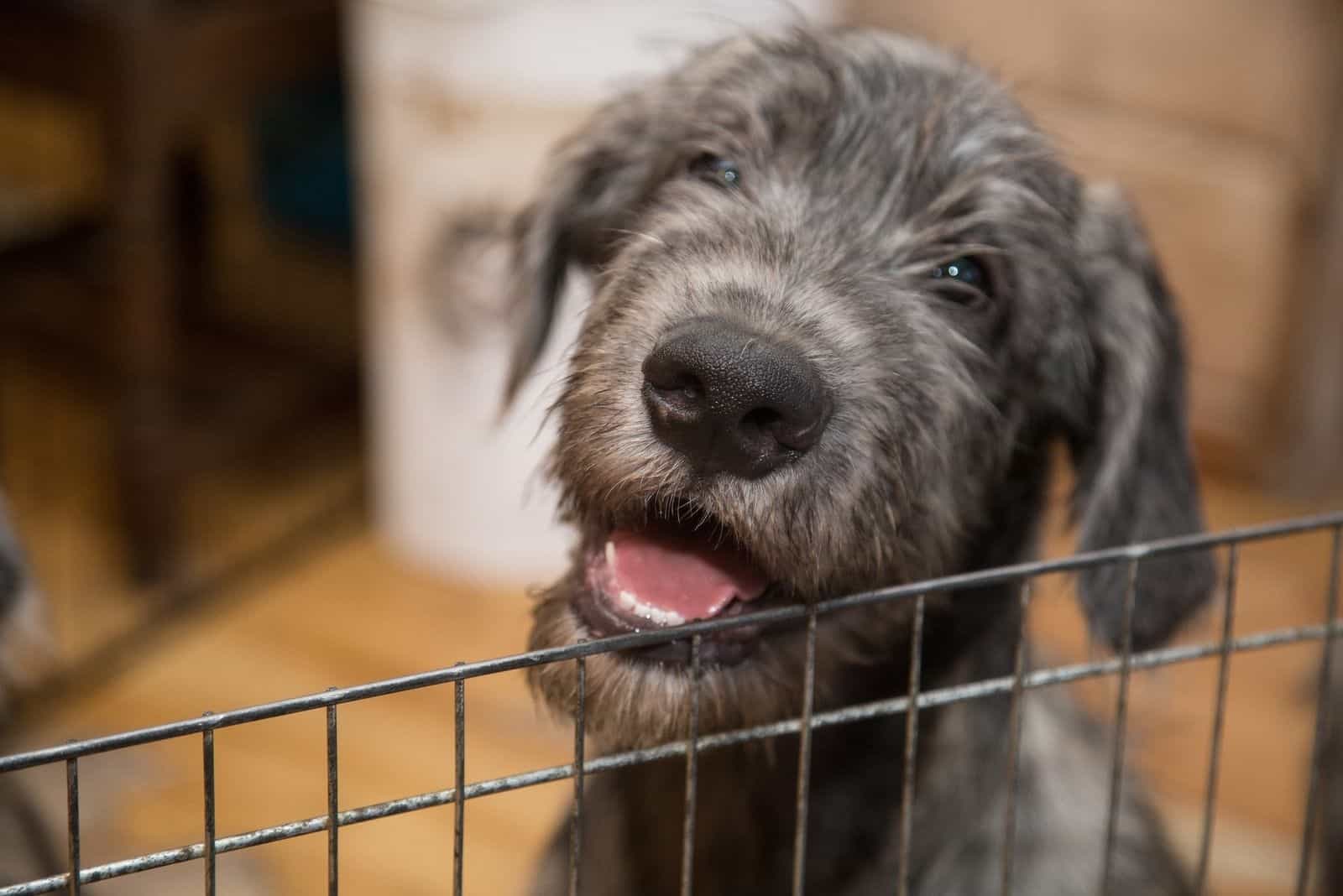
Brush His Teeth
Many Irish Wolfhound owners forget about their dog’s dental hygiene. This is a huge mistake as all dogs are prone to plenty of gum and teeth problems.
While this might not sound dangerous, it’s important to note that dental problems can negatively affect the Irish Wolfhound lifespan.
If anything else, bad teeth and gums lead to an increase of bacteria that will spread to the pup’s stomach. This can be incredibly harmful to your pet.
About 80% of dogs won’t have healthy gums by the age of two. This is enough to showcase how little owners think about taking care of their dog’s teeth, despite this being extremely important.
Don’t Skip Vet Visits
Many of the Irish Wolfhound health problems that we’ve mentioned could be prevented or kept under control if detected on time. Chances are that it’s already too late by the time you notice the first symptoms.
Once you get yourself your Irish Wolfhound puppy, he should get three vet visits during his first year. This is so he can get all the necessary shots and tests done.
A healthy adult dog will need only one yearly check up. However, senior dogs should see their vet more regularly, especially if you know they are prone to some age-related condition.
Only Buy from Reputable Breeders
We know… Purebred Irish Wolfhounds don’t come cheap. It’s easy to think how someone is ripping you off, and that there is no difference between a $500 dog and a $2,000 one – but there is.
Reputable breeders will be expensive, that is true. However, what you likely don’t know is how much money the breeder has invested in the puppy that you’re planning to buy.
This includes initial training and socialization, which is necessary for all dog breeds, as well as nearly perfect living conditions. Most importantly, though, this also includes genetic screenings and testing of both the parent dogs and their offspring.
In other words, even though you’ll pay a higher price initially, you’re actually making sure that you’re getting a dog that is as healthy as possible. If anything else, this will save you thousands, if not hundreds, on medical costs later on.
Not just that, but by supporting responsible breeders, you’re supporting people who are trying to make the breed happy. In the long run, this might lead to a lowered number of cases for certain conditions, and it might prolong the Irish Wolfhound lifespan globally.
So, if you are interested in finding where you can find a healthy Irish Wolfhound puppy, take a look at our list of top 4 Irish Wolfhound breeders in the US!
How to Care for Your Old Dog
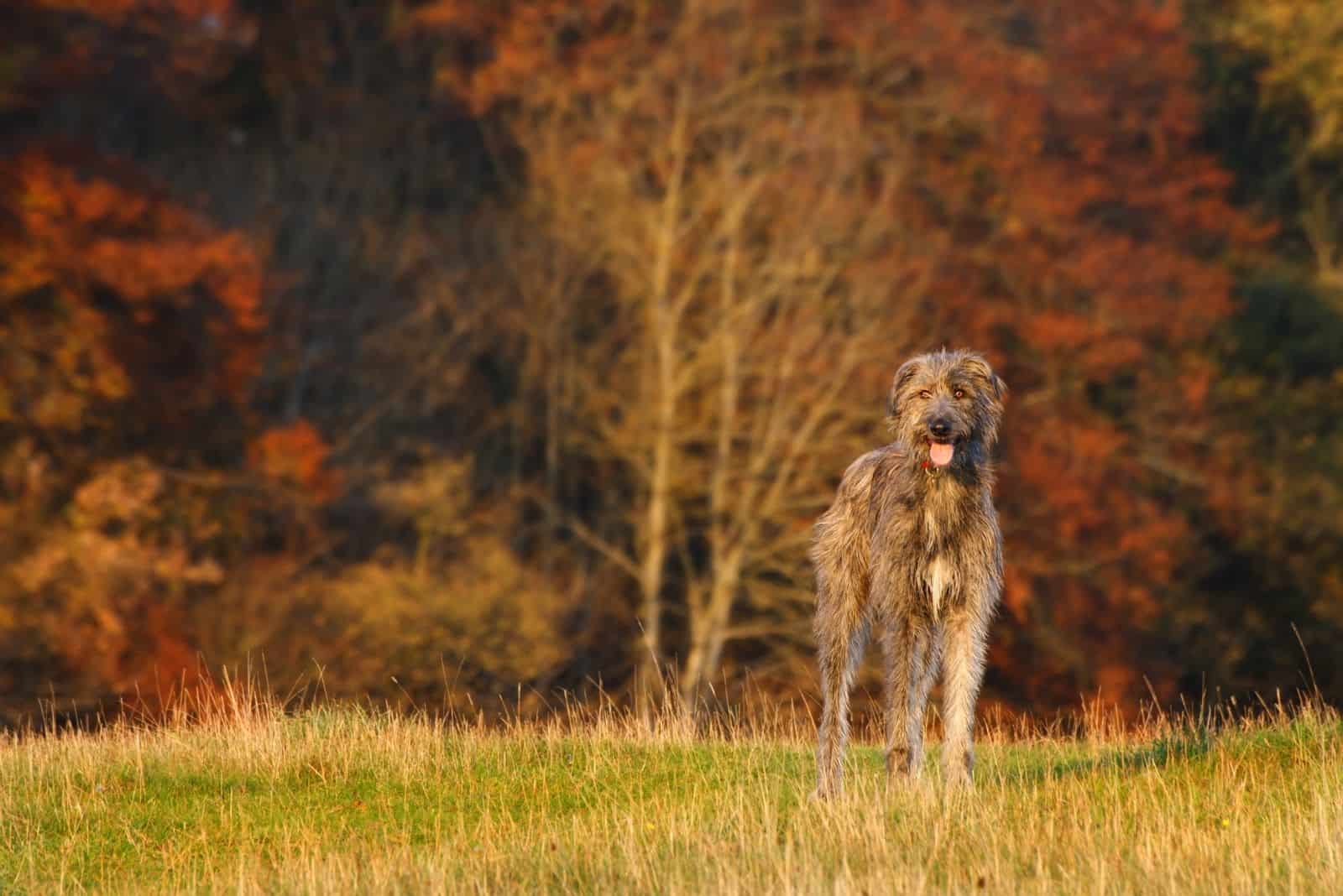
In the owners’ eyes, dogs will always remain puppies. However, a moment will come when you’ll have to face the truth, and that is that your beloved watchdog is slowly but surely becoming a grandpa (or a grandma!).
Once this happens, it’s time to make some adjustments.
Some advice stays the same. You still need to take good care of your old dog’s teeth, and give him regular brushing or even professional teeth cleaning.
Make sure your dog isn’t overeating, and remember to adjust his food as well. Senior dogs don’t need the same nutrients as younger pups, so buy him food that is designed for his age. This includes adding more fiber and decreasing carbohydrates.
Exercise is still important, but don’t go overboard. Irish Wolfhounds are prone to many bone and joint problems.
While exercise is required to keep them healthy, some of these conditions can cause discomfort if they’re ongoing. Not to mention that his bones will now be more fragile!
As mentioned, you’ll need to make sure you’re seeing the vet more regularly. Additional blood tests and overall care might be needed, and that’s perfectly normal. As you grow older, you, too, will require more doctor visits. The same goes for your pooch.
Keep a close eye on your companion, and monitor him very well. Any changes in his behavior or the way that he walks or the amount of food he eats might indicate that something is wrong.
Finally, think about ‘seniorizing’ your home. If your old Irish Wolfhound has hip dysplasia or arthritis, consider building a special ramp so he can still join you in bed or go upstairs.
Keep food and water in areas where he can reach them without too much struggle, especially if you notice his vision is deteriorating. Buy beds adjusted for older dogs. Consider getting the ones that are heated as these can help with sore bones.
While this does involve some work, we think anything is worth it if it will allow us to have a few extra years with our pets!
How Do You Know If Your Irish Wolfhound Is Getting Old?
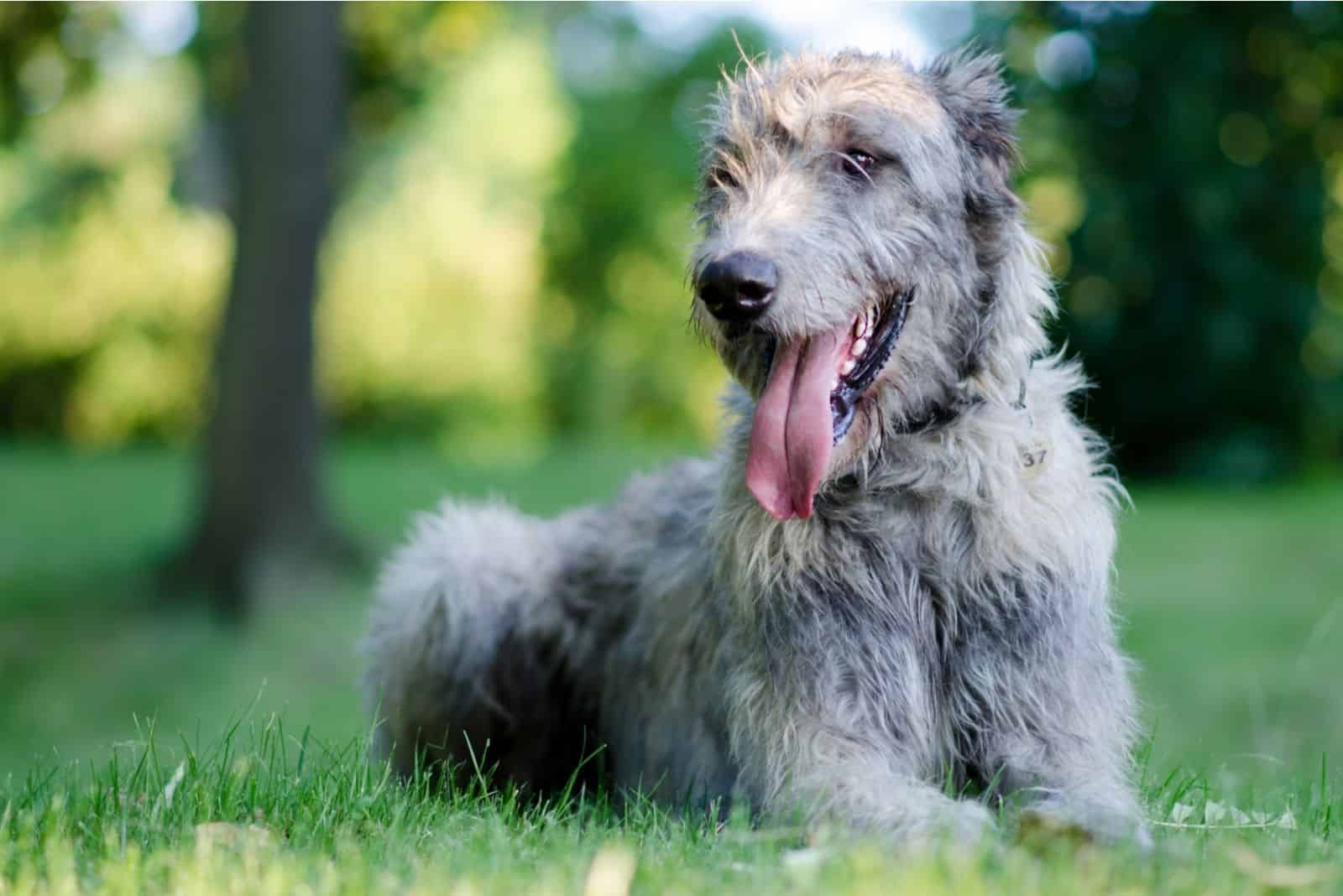
Every dog ages differently. There isn’t an exact age as to when you can say for sure that your dog is now old. Still, there are a few ways that you can know that your Irish Wolfhound is reaching the final stage of life.
First and foremost, you’ll notice the onset of age-related health problems. This includes most joint disorders as well as the beginning of cognitive dysfunction, liver or heart failure, and cancer.
Some age-related changes aren’t necessarily diseases. For example, you may notice infected gums, graying of the hair or hair loss, as well as fatty lumps located right under your dog’s skin.
Aging affects a dog’s behavior as well. You might notice that your dog isn’t as enthusiastic about things as before, or that he’s walking slower than usual. Some older dogs appear to be confused or even unstable.
Unfortunately, most behavioral problems caused by aging cannot be cured, but there are some aging supplements and interactive dog toys that might help slow down the process.
Old dogs tend to sleep more, and aren’t as eager to go on walks. They might be grumpy when woken up, so try to allow them to sleep more.
Even dogs that don’t have arthritis or some similar condition tend to suffer from joint degradation. While symptoms might not be immediately noticeable, you might see your dog appear to be less mobile in the morning or after you return from a long walk.
Once you notice these changes, it’s important to change his exercise habits and try not to overwork him.
An aging dog might experience partial or even complete loss of certain senses. Some older dogs become deaf or blind. As Irish Wolfhounds are prone to PRA, this is something you need to monitor.
These sense degradations are often subtle. Your pet won’t simply become deaf overnight. However, you may notice him bumping into things or becoming less responsive to commands.
Don’t immediately assume that this is bad behavior. Your Irish Wolfhound might just be getting old.
Aging also affects a dog’s metabolism. Your dog might suddenly become overweight, or you may notice him losing a hefty amount of pounds seemingly overnight. All of this can mean that your dog’s body is growing old.
Finally, older dogs might experience some not-so-pleasant problems such as incontinence. Some severe cases might even require you to get your doggie diapers!
The Personality of the Irish Wolfhound
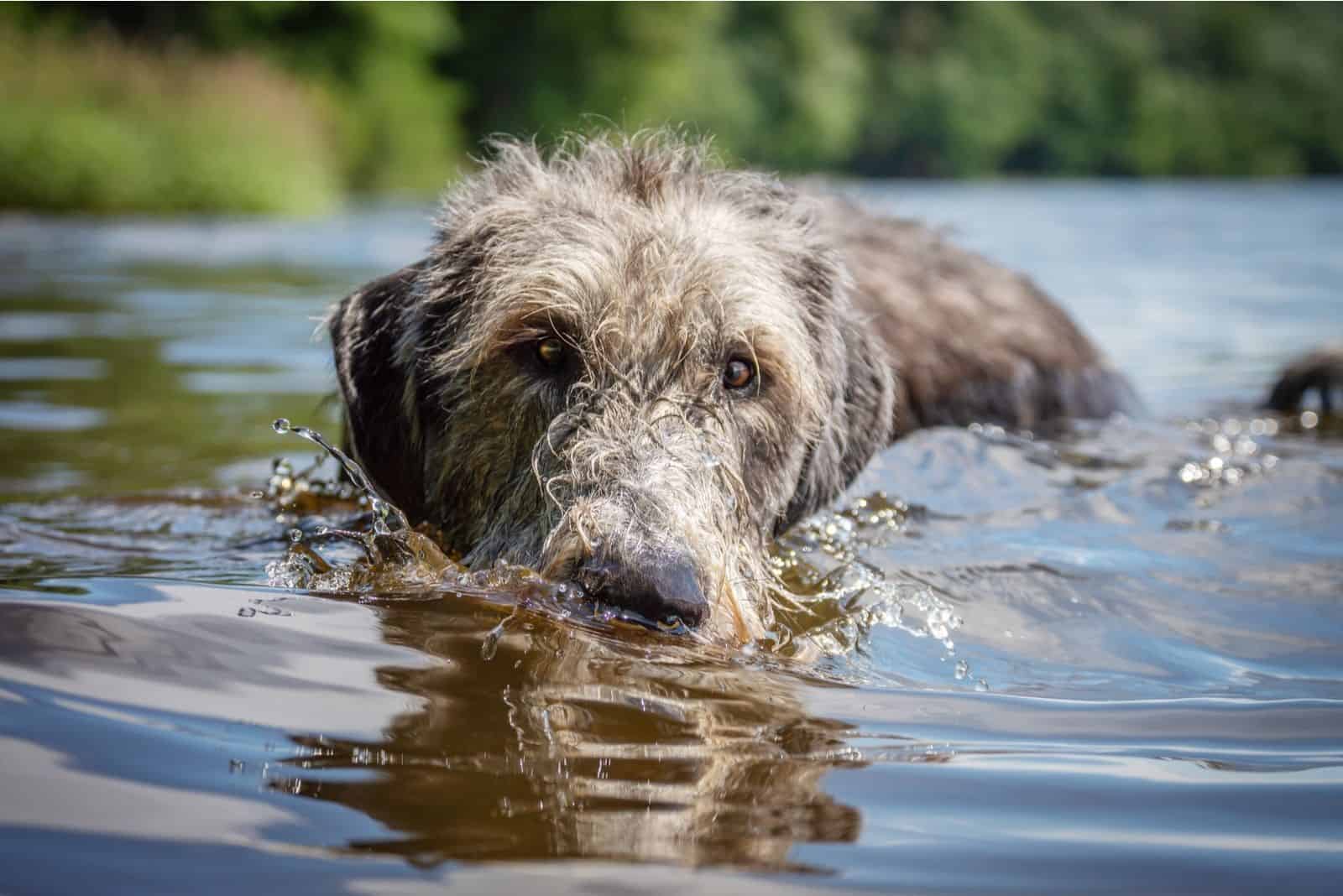
There has been a debate as to whether or not a dog’s personality might affect his life expectancy. While there haven’t been official results yet, it’s easy to see how certain behaviors might negatively affect the Irish Wolfhound lifespan.
Fortunately, Irish Wolfhounds are gentle dogs without a single aggressive trait. They are intelligent and affectionate, and they always want to be in their owner’s company.
Despite their size and energy levels, they are fairly calm, especially when around their families. They are dignified and responsive, and they won’t get into trouble often.
These are sensitive dogs, so any harsh words, yelling, or being physical might do more harm than good. Instead, you should only use positive reinforcement. Otherwise, your Irish Wolfhound might shut down and refuse to cooperate.
Of course, personality is affected by many factors, not just the dog breed. The most important things are proper socialization and training.
If you want to see how your puppy will most likely behave, then always ask the breeder to let you meet its parents, or at least its mother.
Also, while they might be cute, try not to pick the puppy that is spending all its time fighting with his littermates. These pups might end up being a bit more aggressive than you’d like, and they aren’t a good choice.
As this isn’t an aggressive, mischievous dog, his temperament likely won’t affect his lifespan much. This is good news for all aspiring Irish Wolfhound owners who might not be prepared to keep such a large dog under control.
Still, it’s always recommended that you keep your dog on a leash, and double-check if the back yard doors are closed. If your dog gets loose, he might get hurt, especially if you’re located near a busy street.
Is the Irish Wolfhound a Good Family Dog?
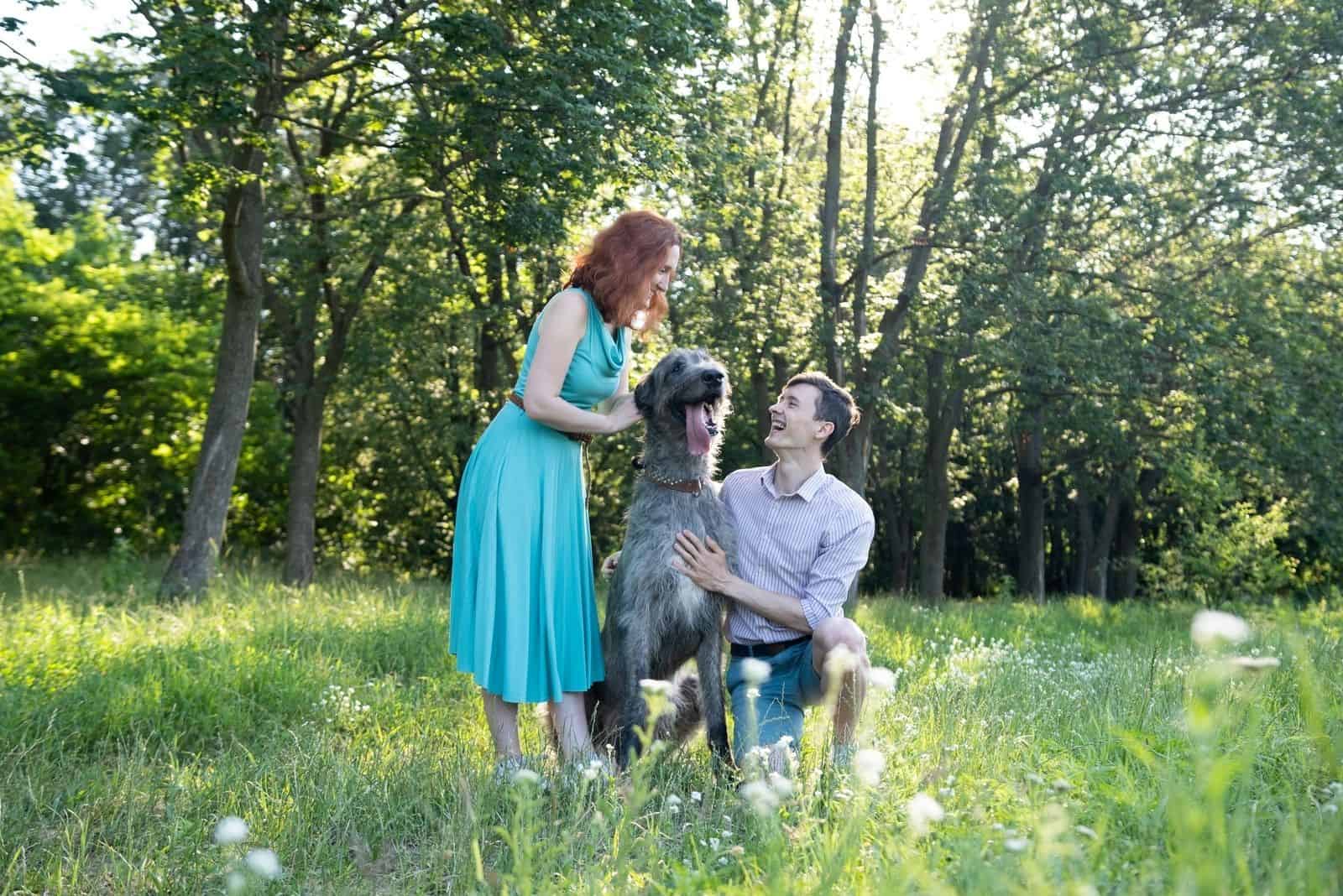
Overall, Irish Wolfhounds have the temperament to become wonderful family pets. They are calm, loyal, and patient, and they will keep you protected all the time. It is not like anyone would dare to harm you when they see such a large dog by your side!
However, there are two big downsides that might not make them the best choice for families with small children.
First off, these are giant dogs. While gentle, they might accidentally knock a child over when they are doing nothing but walking! They might also cause serious harm during rough play as they aren’t aware of the strength they possess.
Unfortunately, the fact that the Irish Wolfhound lifespan is so short might also be the reason not to get them as a child’s pet.
Small kids might not understand death, and losing their family pet can traumatize them. They might not realize why their companion is no longer with them, and this could leave an emotional scar.
There are some things you can do to ensure that your Irish Wolfhound stays with you for as long as possible.
If you take care about the food he eats, take him on regular vet visits, and buy from reputable breeders, you might ensure that you have your pet for over a decade.
Sadly, the Irish Wolfhound is a short-lived breed, and there is little you can do about that. The best thing for both you and your pup would be to love and care for it for as much time as it is given, and to give your Irish Wolfhound dog the best life possible.
Read Next: 22 Irish Wolfhound Colors To Make Your Day (With Pictures)
